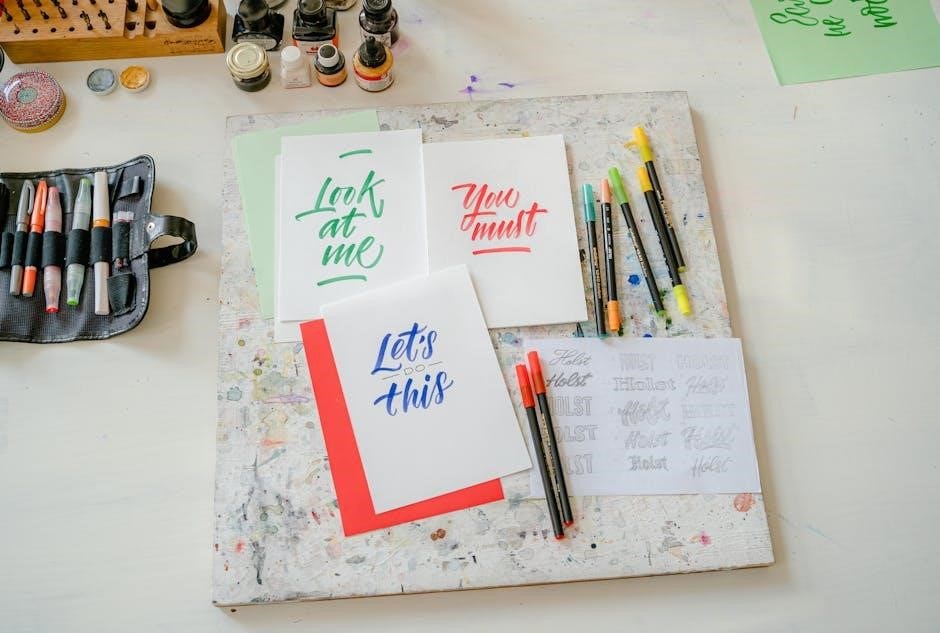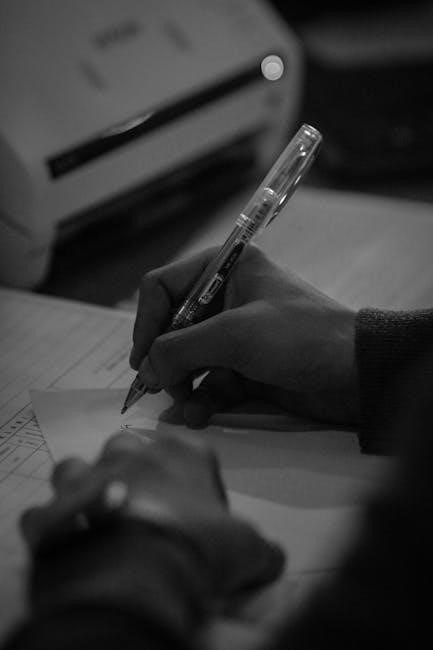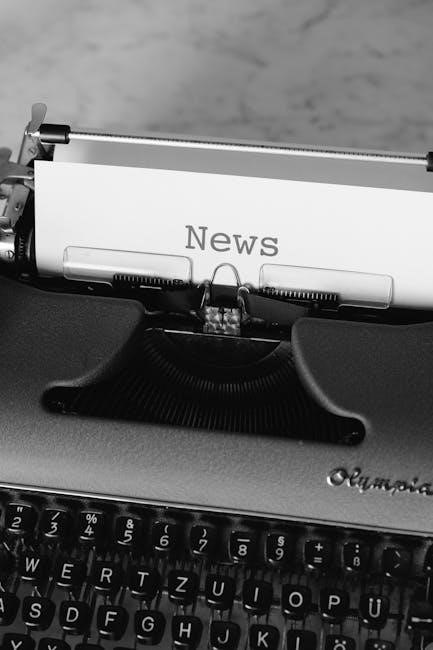Lettering is the artistic creation of custom letterforms, blending creativity and technical skill. It enhances visual communication, making messages more engaging and memorable. Essential for designers, it requires patience and practice.
1.1 What is Lettering?
Lettering is the art of creating custom letterforms by hand or digitally, emphasizing uniqueness and creativity. Unlike typography, which uses pre-designed fonts, lettering allows for personalized expression, making each letter or word visually distinct. It combines artistic flair with technical precision, enabling designers to craft visually appealing and meaningful text. Whether decorative or functional, lettering enhances communication, making it a versatile tool in design, art, and branding.
1.2 Importance of Lettering in Design
Lettering plays a crucial role in design by adding personality and emotion to text, making it visually engaging. It enhances brand identity, captures attention, and conveys messages effectively. Unlike standard fonts, custom lettering allows for uniqueness, creativity, and adaptability in various mediums. Whether in branding, advertising, or art, lettering elevates communication, creating a lasting impression. Its versatility makes it essential for designers aiming to stand out in both digital and print formats.
1.3 Brief History of Lettering
Lettering traces its roots to ancient civilizations, with early examples seen in Egyptian hieroglyphs and Roman inscriptions. The Renaissance revived interest in hand-drawn letterforms, while the Industrial Revolution brought mass-produced typography. The 20th century saw lettering evolve with graphic design, and today, digital tools have transformed its creation. This rich history highlights lettering’s enduring role in communication, blending artistry and functionality across cultures and eras, influencing modern design practices and creative expression.

Essential Tools for Drafting Lettering
Explore traditional tools like pens, brushes, and markers, alongside digital options such as graphics tablets and software. These tools enable precise lettering, enhancing creativity and detail.
2.1 Traditional Tools: Pens, Brushes, and Markers
Traditional tools like pens, brushes, and markers are essential for hand lettering. Pens offer precision and control, while brushes create dynamic line variations. Markers provide vibrant colors and versatility.Nibs and calligraphy pens are popular for intricate designs. Brushes, such as flat or round tips, allow for expressive strokes. Markers like Copic or Prismacolor are great for coloring and shading. These tools enable artists to explore various styles, from delicate scripts to bold typography, making them indispensable for creating unique and artistic lettering pieces.
2.2 Digital Tools: Software and Graphics Tablets
Digital tools like software and graphics tablets revolutionize lettering by offering precision and flexibility. Adobe Illustrator and Procreate are popular for creating vector-based designs. Graphics tablets, such as Wacom, allow artists to draw directly on screens with accuracy. These tools enable customization, layering, and easy edits, making the design process efficient. They also support scalability and consistency, essential for professional lettering projects. Digital tools open up endless creative possibilities, blending tradition with modern technology for stunning results.
2.3 Paper and Surfaces for Lettering
The choice of paper and surfaces significantly impacts lettering quality. Smooth, high-quality paper is ideal for precise strokes, while textured paper adds artistic effects. For ink-based tools, bleed-resistant paper is essential to prevent smudging. Surfaces like drawing boards or digital tablets also play a role, offering stability and control. Selecting the right paper ensures durability and clarity, enhancing the overall appearance of your lettering work. Experimenting with different surfaces can expand your creative possibilities and refine your technique.

Basic Lettering Techniques
Mastering basic lettering techniques involves understanding letter forms, practicing strokes, and managing spacing. These fundamentals are essential for creating clear, readable, and aesthetically pleasing typography.
3.1 Understanding Letter Forms and Anatomy
Understanding letter forms and anatomy is crucial for effective lettering. It involves studying the structure of letters, including serifs, stems, bowls, and terminals. The anatomy of letters determines their readability, style, and aesthetic appeal. By analyzing these elements, artists can create consistent and visually pleasing typography. Proper understanding of letter forms helps in maintaining uniformity and proportions, essential for professional design. This foundation is key to mastering more complex techniques in lettering and typography.
3.2 Practicing Basic Strokes and Lines
Mastering basic strokes and lines is fundamental to lettering. Start with vertical, horizontal, and diagonal lines to build consistency. Practice curves and flourishes to enhance fluidity. Use tools like pens, brushes, or markers to explore varying line widths and textures. Regular practice improves muscle memory and lettering precision. Focus on maintaining even pressure and steady movement to achieve smooth, balanced strokes. This foundational skill is essential for creating cohesive and visually appealing letterforms in any style or design.
3.3 Spacing and Alignment in Lettering
Proper spacing and alignment are crucial for readability and visual appeal in lettering. Kerning adjusts space between individual letters, while tracking affects entire blocks of text. Practice aligning letters to a baseline or centerline for consistency. Use guides or grids to ensure accuracy. Balanced spacing enhances clarity, while intentional misalignment can create dynamic effects. Experiment with spacing to convey rhythm and emphasis, ensuring each design element complements the overall composition. This skill elevates lettering from functional to artistic.
Design Principles for Effective Lettering
Effective lettering relies on balance, contrast, and harmony. Balance ensures stability, while contrast creates visual hierarchy. Harmony unifies elements, making designs aesthetically pleasing and engaging.
4.1 Balance and Symmetry
Balanced lettering ensures visual stability, while symmetry creates order. Symmetrical designs mirror elements, enhancing readability and aesthetics. Balance distributes weight evenly, preventing visual overload. Proper alignment and spacing maintain harmony, making lettering more engaging. Symmetry can be axial or radial, adding structure. Experimenting with balance and symmetry improves composition, ensuring letters and words are visually appealing and professional.
4.2 Contrast and Visual Hierarchy
Contrast and visual hierarchy are key to making lettering stand out; High contrast between elements like size, color, and weight draws attention, guiding the viewer’s eye. A clear hierarchy ensures important elements are emphasized, improving readability and engagement. Techniques like varying font sizes, bolding, and color differentiation help create visual flow. Balancing contrast with harmony ensures the design remains cohesive while directing focus effectively.
4.3 Harmony and Consistency
Harmony in lettering ensures all elements work together seamlessly, creating a cohesive design. Consistency maintains uniformity in letterforms, spacing, and style, making the piece visually appealing. Achieving harmony involves balancing typography, color, and layout, while consistency ensures repeated design elements remain uniform. These principles guide the viewer’s eye smoothly through the composition, enhancing readability and aesthetic appeal. Proper execution of harmony and consistency elevates the overall impact of the lettering, making it professional and engaging.

Typography Basics
Typography is the foundation of lettering, focusing on font selection, size, and arrangement to ensure readability and visual appeal in written communication, enhancing the message’s impact effectively.
5.1 Serif vs; Sans Serif Fonts
Serif fonts, like Times New Roman, feature small lines at letter endings, enhancing readability in print. Sans serif fonts, such as Helvetica, lack these lines, offering a clean, modern aesthetic. Serif fonts are traditionally used in long-form text for their readability, while sans serif fonts excel in digital interfaces due to their clarity on screens. Understanding the differences helps designers choose the right font for their medium, ensuring optimal legibility and visual appeal in various applications, from print to web design.
5.2 Choosing the Right Font for Your Design
Selecting the appropriate font is crucial for effectively communicating your message. Consider the design context, audience, and intended use. Fonts vary in style, from elegant scripts to bold sans serifs, each evoking different emotions. Legibility is key, especially for digital interfaces, where clarity on screens is vital. Experiment with font pairs to create contrast and visual hierarchy. Tools like font libraries and preview features can aid in making informed decisions, ensuring the chosen font aligns with your design’s purpose and enhances its overall impact.
5.3 Kerning and Tracking in Lettering
Kerning adjusts the space between specific pairs of letters, ensuring readability and visual balance. Tracking modifies the uniform spacing between all letters in a text block, affecting the overall appearance. Proper kerning and tracking enhance the legibility and aesthetic appeal of lettering. They help guide the viewer’s eye and create a cohesive design. Adjusting these elements requires attention to detail and an understanding of how spacing impacts the message. Use design software to fine-tune these settings for professional results.

Advanced Lettering Techniques
Advanced techniques involve creating intricate custom letterforms, adding decorative flourishes, and experimenting with 3D effects and shadows. These methods elevate lettering, adding depth and sophistication to designs.
6.1 Creating Custom Letterforms
Creating custom letterforms involves crafting unique, hand-drawn characters tailored to specific designs. Start with sketches, refining shapes and proportions. Use digital tools to perfect intricate details, ensuring consistency across the alphabet. Experiment with calligraphic flourishes or minimalist styles. Custom letterforms enhance brand identity and artistic expression, making each design stand out. Practice with various tools and techniques to master this advanced skill, essential for professional lettering artists.
6.2 Adding Decorative Elements
Decorative elements like flourishes, borders, and shadows elevate lettering, adding visual interest. Start with simple flourishes on letter ends, then gradually incorporate intricate details. Use contrasting colors or gradients to highlight elements. Digital tools allow precise control over effects, ensuring they enhance readability. Experiment with subtle textures or patterns to add depth. Balance creativity with legibility to avoid overwhelming the design. Practice blending decorative elements seamlessly into your lettering for a polished, professional finish.
6.3 3D and Shadow Effects in Lettering
Adding 3D and shadow effects enhances lettering by creating depth and dimension. Use layering and shading techniques to give letters a three-dimensional appearance. Digital tools like Adobe Illustrator offer features for precise control over effects. Experiment with drop shadows and gradients to add complexity. Ensure that effects complement the design without compromising readability. Practice balancing creativity with functionality to achieve visually striking yet legible lettering.
Digitizing Your Lettering
Digitizing lettering involves scanning and editing hand-drawn designs using software like Adobe Illustrator. This process enhances precision, scalability, and versatility for digital or print applications.
7.1 Scanning and Editing Hand-Drawn Lettering
Scanning and editing hand-drawn lettering transforms your artwork into a digital format. Use a high-quality scanner or graphics tablet to capture your work. Edit using software like Adobe Illustrator or Photoshop to refine details, adjust contrast, and clean up imperfections. This step ensures your lettering is sharp, scalable, and ready for digital or print use. Proper editing enhances the overall quality and prepares your design for professional applications.
7.2 Using Adobe Illustrator for Vector Lettering
Adobe Illustrator is a powerful tool for creating and refining vector lettering. Use the Pen Tool to trace hand-drawn letters, ensuring scalability. The Shape Builder and Pathfinder tools help refine shapes and paths. Adjust strokes, fills, and effects to enhance your design. Vector lettering remains crisp at any size, making it ideal for both print and digital formats. Proper layer organization and workflow streamline the editing process, ensuring professional-quality results for your lettering projects.
7.3 Preparing Lettering for Print and Digital Use
Preparing lettering for print requires high-resolution files (300 DPI) and CMYK color mode. For digital use, RGB mode and lower resolutions (72 DPI) suffice. Ensure proper bleed and margins for print. Convert text to outlines to avoid font issues. Use transparent backgrounds for digital flexibility. Export in formats like PDF, SVG, or PNG. Test designs across devices for consistency. Proper preparation ensures clarity and professional quality in both mediums, whether for signage, websites, or publications.

Practice and Improvement
Consistent practice enhances lettering skills, fostering creativity and precision. Regular exercises refine technique and build confidence in creating beautiful, impactful designs.
8.1 Daily Exercises for Better Lettering
Engaging in daily lettering exercises sharpens skills and builds consistency. Start with basic strokes, such as lines and curves, to improve muscle memory. Practice replicating various fonts to understand their structure. Dedicate time to creating simple words or phrases, focusing on spacing and alignment. Incorporate warm-up drills, like writing the alphabet, to refine letterforms. Gradually experiment with more complex designs, such as quotes or short sentences, to enhance creativity. Regular practice fosters improvement and confidence in lettering.
8.2Analyzing and Learning from Famous Lettering Artists
8.2 Analyzing and Learning from Famous Lettering Artists
Studying renowned lettering artists offers valuable insights into techniques and styles. Analyze their work to understand composition, creativity, and attention to detail. Gain inspiration from their unique approaches and incorporate elements into your own practice. Observing how they balance aesthetics and functionality can refine your skills. Learning from their processes helps identify strengths and areas for improvement, fostering growth as a lettering artist.
8.3 Getting Feedback on Your Work
Seeking feedback is crucial for improving lettering skills. Share your work with peers, mentors, or online communities to gain diverse perspectives. Constructive criticism helps identify areas for refinement and enhances creativity. Being open to feedback fosters growth and adaptability. Regular reviews allow you to refine techniques, ensuring your work aligns with artistic and technical standards. Feedback is a powerful tool for polishing your craft and achieving professional-quality lettering.

Applications of Lettering
Lettering is widely used in branding, advertising, signage, and art. It enhances visual communication, making messages stand out in various creative and professional contexts effectively.
9.1 Lettering in Branding and Logo Design
Lettering is crucial in branding and logo design, creating unique identities that reflect a brand’s values. Custom letterforms differentiate brands, ensuring recognition and memorability. Versatile across mediums, lettering maintains consistency in digital and print, enhancing brand coherence. It balances aesthetics with functionality, making logos visually appealing and recognizable. Effective lettering builds trust and communicates messages clearly, using various tools and techniques for a professional finish.
9.2 Hand Lettering in Signage and Advertising
Hand lettering captivates audiences in signage and advertising, creating emotional connections through unique, handcrafted designs. Versatile for billboards, storefronts, or digital ads, it adds authenticity and charm. Script, bold, or decorative styles enhance visual appeal, making messages stand out. Effective lettering balances aesthetics with readability, ensuring clear communication. It adapts to diverse environments, from urban streets to retail spaces, while maintaining brand consistency. Practice and digital tools refine designs, making hand lettering a powerful tool in modern advertising.
9.3 Lettering in Art and Calligraphy
Lettering in art and calligraphy combines creativity with technical precision, creating visually stunning pieces. It expresses emotions through elegant typography and intricate designs. Calligraphy, a traditional art form, emphasizes fluid strokes and ornamental details. Lettering in art often explores experimental styles, blending modern techniques with timeless aesthetics. Exhibited in galleries, murals, or digital platforms, it inspires and engages viewers. This art form highlights cultural heritage while evolving with contemporary tools and digital advancements, making it a timeless medium for creative expression.
Case Studies and Examples
Case studies highlight successful lettering projects, showcasing real-world applications and their impact. These examples inspire creativity and demonstrate effective lettering techniques in various design contexts.
10.1 Famous Lettering Projects
Famous lettering projects, like hand-lettered movie titles for “Harry Potter” and “Pirates of the Caribbean,” showcase creativity and emotional impact. Iconic branding examples, such as Coca-Cola and Disney, demonstrate lettering’s power in identity design. These projects highlight how custom letterforms can elevate storytelling and brand recognition, inspiring lettering artists to push creative boundaries and explore new visual languages in their work.
10.2 Successful Lettering in Real-World Scenarios
Successful lettering is evident in signage, advertising, and branding, where clarity and aesthetics combine to communicate effectively. Examples include store signage, billboard ads, and product packaging. Lettering enhances readability and emotional appeal, making it a key element in wayfinding systems and promotional materials. Its versatility allows it to adapt to various contexts, ensuring messages resonate with diverse audiences while maintaining functionality and artistic flair in real-world applications.
Troubleshooting Common Mistakes
Common mistakes in lettering include uneven letters and inconsistent spacing. Using guides and grids can help, while patience and practice refine skills over time. Regularly reviewing your work and learning from errors is key to improvement, ensuring professional-looking results.
11.1 Avoiding Proportion Errors
Proportion errors in lettering occur when letters are uneven or inconsistent in size and shape. To avoid this, use reference grids or light boxes to maintain uniformity. Ensure all letters adhere to a consistent height and width ratio. Regular practice and critiquing your work can help identify and correct these issues. Pay attention to the balance between thick and thin strokes, as uneven proportions can distract from the overall design. Proper planning and patience are key to achieving harmony in lettering.
11.2 Fixing Spacing and Alignment Issues
Spacing and alignment issues in lettering can disrupt readability and aesthetics. To fix these, ensure consistent letter spacing by measuring gaps between characters. Use alignment guides or rulers to straighten letters. Adjust kerning and tracking to avoid overcrowding or unevenness. Practice with grid paper to improve accuracy. Regularly review your work from different angles to catch errors. Digital tools can also help automate or refine spacing for precise results. Attention to detail is crucial for professional-looking lettering.
Lettering is a blend of creativity and technical skill, essential for effective communication. Regular practice and attention to detail refine your craft. Embrace continuous learning to master this art form.
12.1 Summarizing Key Points
Lettering combines artistic creativity with technical precision, enhancing visual communication through custom letterforms. Essential tools range from traditional pens to digital software, aiding in the creative process. Practice and patience refine skills, while understanding design principles ensures balance and harmony. From typography basics to advanced techniques, consistent effort leads to mastery. Embrace feedback and stay inspired by renowned artists to continually improve and adapt in this evolving field of artistic expression.
12.2 Encouragement for Continued Practice
Embrace lettering as a journey of growth and creativity. Dedicate time to practice, and celebrate small victories along the way. Every stroke and letter brings you closer to mastery. Stay inspired by exploring new styles and techniques, and don’t hesitate to seek feedback. Remember, persistence and passion will elevate your skills and open doors to exciting creative opportunities. Keep striving, and enjoy the rewarding process of crafting beautiful letterforms.
